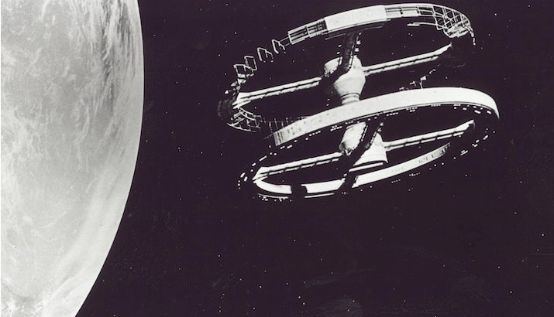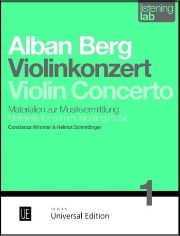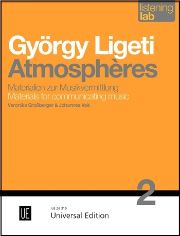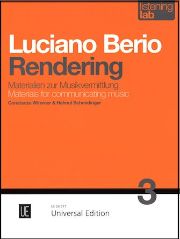Access to the inaccessible
"Listening Lab" offers materials and suggestions for discovering key works of New Music with children and young people.

How to teach new music? How can music that is perceived as inaccessible be made accessible in the classroom? With Listening Lab, Universal Edition has started a series of booklets that show ways of approaching music in a broad-based way that involves all the senses.
The individual "workshops" within the booklets are aimed at different age groups. There are projects and games for children as well as for young people and adults. However, according to the authors, this information on the target audience should not be understood as absolute, but rather as adapting the language and working methods to the groups.
Twelve-tone row as a basis
Constanze Wimmer and Helmut Schmidinger are the first to present material relating to Alban Berg's violin concerto. This work is considered by many to be one of the most important concertos of the 20th century. At the beginning, the empty strings of the violin sound G-D-A-E. The piece, which is based on a twelve-tone row, develops from these four notes. A Carinthian folk song (Ein Vogerl aufm Zwetschgenbaum) and a Bach chorale (Es ist genug) are interwoven into the piece, as well as a waltz and the rhythm of a dance of death. All ingredients that reflect the extra-musical context. Berg dedicates his work to Manon Gropius, the daughter of Alma Mahler, who dies of polio at the age of 19, and subtitles it "To the memory of an angel". Death and grief, pain and love are palpable in this music.
Constanze Wimmer gains access to the work from the music itself and from the story that surrounds it. For example, in the "search for fifths": fifths are sung in pairs, one person plays a note and the other searches for the fifth. Or the previously detuned string instruments have to be tuned correctly. You can create your own personal twelve-tone series by noting down the letters of your own name as musical notes and then trying out the tone sequence with the baton. In the "Portrait Sound Painting Project Proposal", practical concepts show how you can immerse yourself in the world of Berg's violin concerto by playing, composing and experimenting.
The booklet offers many suggestions and tips for lessons. There is also a wealth of background information, and the many quotes from Th. W. Adorno and Willi Reich are particularly interesting.
Texture from 80 voices
Atmosphères! György Ligeti's work is a colossus of sound, shimmering, incomprehensible, disturbing. But even at its premiere in Donaueschingen in 1961, listeners immediately realized that this was something new, something truly new. A musical landmark of the 20th century. The piece became famous through Stanley Kubrick's film 2001: A Space Odyssey.
How can you immerse yourself in these cluster sounds without drowning and listening away? The melodies of the 80 individual voices seem like a textile fabric, sometimes tightly woven, sometimes broadly woven. There are no clearly delineated formal sections, no repetitions, no striking melodic or rhythmic shapes, no contrasting themes. The sound fields overlap and flow into one another, like the colors in the Unpainted pictures Emil Nolde's.
The authors Veronika Grossberger and Johannes Voit approach the piece on different levels. By means of research (analyses and quotations), listening, invention, imagination and interaction: Listening to the film music: What function does the music fulfill in the film? What do the Atmosphères in Kubrick's universe? Invent: You invent an unusual sound on an instrument or some other object. Take it to an alien planet - what happens there? Invent a story and set it to music ... Imagination: Observe the clouds. How they change, deform, dissolve. Tempo, dynamics, consistency. Interaction: Explore air sounds - on wind instruments, on string and percussion instruments, with your own body. Create an atmosphere. Clouds of sound rise up. Perhaps in a group improvisation. In addition, the playing instructions from the score - senza colore, molto vibrato. When does a sound begin to vibrate? When does it freeze? These sounds can be transformed into a pantomime performance.
The focus of the materials is on experience-oriented and activating settings, prepared for children, young people and adults.
Completing the unfinished
Just to avoid any possible misunderstanding: We are not talking about Schubert's Unfinished Symphony in B minor, D 759, but about the 10th Symphony (D 936A), which only exists in sketches. In Rendering from 1989, the Italian composer Luciano Berio attempts to bring together these fragments and sketches of Schubert's Tenth and complete them into a fully orchestrated work. In doing so, he supplements Schubert's music with his own compositions. Berio does this in a respectful manner. In his restorations, reconstructions and musical additions, he integrates Schubert's motifs. The formal structure and orchestration (with the exception of the celesta) are also based on Schubert's instructions. And yet a new music emerges with sound surfaces that Berio describes as his "musical cement", with which he cements the fragments.
Who is Luciano Berio? How does he complete Schubert's music? How does Rendering approach? As in the other issues, the authors draw on the pattern of "research, imagination and interaction". In the research sections, for example, the phenomenon of unfinished symphonies is explored, not only those by Schubert, but also by Beethoven and others. The clash of old and new is the subject of the imaginations. Schubert and Berio, past and present. How do times and people, memories and new creations interlock? Based on the Metamorphosesa series of pictures by M. C. Escher, transitions - intersections and intersections in the picture compositions, musical overlays in the sound compositions - are depicted. The interactions are about composing, about doing it yourself, for example by filling a melody with gaps with music. So what does a composer do (the title of one project proposal)? He plays with building blocks and invents exciting stories! You can find inspiring instructions here.
The latest issues deal with the Notations by Pierre Boulez and Béla Bartók's Music for string instruments, percussion and celesta.
Constanze Wimmer, Helmut Schmidinger, Alban Berg Violin Concerto. Materialien zur Musikvermittlung, Listening Lab 1, UE 26315, € 39.95, Universal Edition, Vienna
Veronika Grossberger, Johannes Voit, György Ligeti Atmosphères. Listening Lab 2,
UE 26316, € 39.95
Constanze Wimmer, Helmut Schmidinger, Luciano Berio Rendering, Listening Lab 3,
UE 26317, € 39.95







